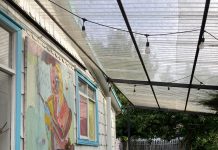Lauren Luna
Campus Beat Reporter
Since 2014, UC Regents has been an instrumental benefactor in funding the Thirty Meter Telescope (TMT) atop Mauna Kea, a dormant volcano on Hawaii Island.
The project’s website states that the venture will “solidify the position of Hawaii as a World leader in research in astronomy and astrophysics,” as a sustainable advancement in science. According to the website, the project does not intrude on any archaeological sites or endangered wildlife on the island.
On Thursday, Nov. 12, a UC Santa Barbara (UCSB) organization by the name of Mauna Kea Protectors (MKP) held a workshop for their #UCDivestTMT campaign, which calls for funds for the project to be withdrawn. The workshop capped off the campaign’s week of action, calling for Chancellor Yang, the chairman of the project, to divest money from the TMT Project in accordance with Native Hawaiian students’ judgement and their UCSB supporters.
The TMT project supporters have been pushing for the telescope’s completion in order to further study the space phenomenon of quasars. According to the online SAO Encyclopedia of Astronomy (COSMOS), quasars are celestial bodies that garner a tremendous amount of pure energy, theorized to be powered by immense black holes. Some astronomers believe the phenomenon represents a stage in the life of a galaxy, expanding outwards yet pulling old matter within.
“On Thursday, November 12, a UCSB organization by the name of Maunakea Protectors (MKP) held a workshop for their #UCDivestTMT campaign, which calls for funds for the project to be withdrawn.”
“Through University of California Observatories, we have privileged access to the Keck telescopes on the summit of Mauna Kea, which allowed us to obtain high-quality data on this object shortly after it was discovered using the Gemini telescope,” commented physics professor Joe Hennawi in an interview with UCSB’s official news site, The Current.
Members of the Hawaiian diaspora as well as natives of the island itself have demonstrated dissatisfaction with the venture. The summit is one of the most sacred places in Hawaiian cosmology, analogous to the “Garden of Eden” in Abrahamic religions. According to Trisha Kehualani, writer for Vox Magazine, Mauna Kea not only houses fragile natural resources, but also numerous cultural resources and “historic burial sites.”
TMT’s construction atop Mauna Kea has also promoted civil unrest within the Hawaiian community, as law enforcement has reportedly taken the opportunity to have native Hawaiian officers regulate the site without popular consent.
“The use of Native Hawaiian law enforcement has been met with harsh criticism,” reports Kehualani. “Many consider it an intentional decision by government leaders, who are primarily non-Hawaiian, to create division and trauma within the Hawaiian community.”
Native Hawaiians who want to preserve Mauna Kea do not agree that their fight is a conflict between science and culture. On the contrary, they are strong proponents for advancements in science, but simply believe the telescope does not belong on Mauna Kea.
Earlier this May, the Daily Californian, a student-run newspaper at UC Berkeley, reported that the UC System newly invested a whopping $68 million into the Thirty-Meter Telescope project. Thus, the Mauna Kea Protectors at UCSB have led a student-backed resistance against the continuation of the project.
“Native Hawaiians who want to preserve Maunakea do not agree that their fight is a conflict between science and culture. On the contrary, they are strong proponents for advancements in science, but simply believe the telescope does not belong on Maunakea.”
The Mauna Kea Protectors’ workshop last Thursday kicked off with a brief introduction to the history of Mauna Kea, prefacing its significance to native Hawaiians. The presentation then explained UCSB’s involvement in the Mauna Kea project, specifically citing Yang’s public endorsement and leadership within the project, which extends back to before 2009.
Along with being regarded as a violation of Mauna Kea’s spiritual significance, this project has also garnered further controversy as it led to the arrests of Hawaiian elders who peacefully protested on the Mauna Kea site in the summer of 2019. According to New York Times, authorities did not provide numbers of arrests and the charges, which the elders would anticipate, but witnesses described the scene as “emotional, but peaceful.”
Many UCSB students, even those outside of the Hawaiian community, feel strongly opposed to this issue. Student Jeike Meijer, who is a part of the Taino indigenous community from the Caribbean, aired her opinions on the Mauna Kea venture in a Q&A session following the presentation.
“My experience with Chancellor Yang has not felt reciprocal,” explained student Jeike Meijer. “I have not felt listened to in the conversations, and I have not been taken seriously.”
“My experience with Chancellor Yang has not felt reciprocal,” explained Meijer. “I have not felt listened to in the conversations, and I have not been taken seriously.”
This experience is not unique, as other UCSB students have taken to communicating with Yang over the phone, email, or social media to urge him and UC Regents to divest from the project. Yang has stated that he is in support of the Hawaiian community but has not expressed any intention to withdraw funds from the TMT project.








Many of the protestor’s claims are, to the surprise of nobody, proven false or not based on any sort of fact or logic. It’s a real shame
Comments are closed.